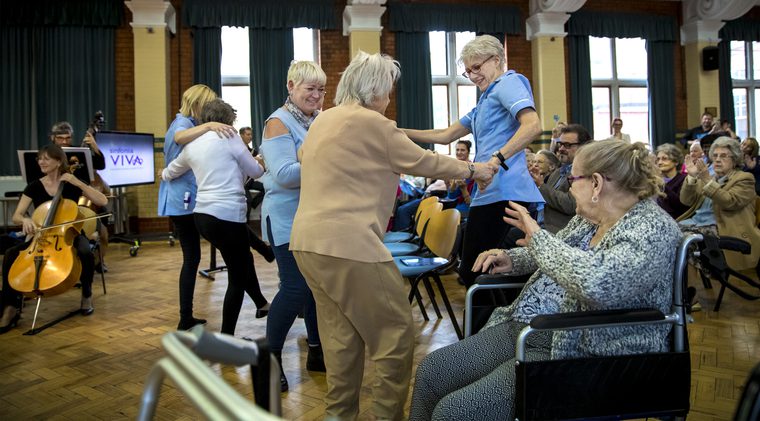Orchestras in Healthcare report launch
NewsNews Story
Sarah Derbyshire, our CEO, introduces the headlines from her co-authored report, Orchestras in Healthcare outlining what she believes the sector needs to do next to extend provision and opportunities to more healthcare settings across the UK.
Almost exactly a year ago, Matthew Swann (City of London Sinfonia), Fiona Harvey (Association of British Orchestras) and I broached the idea of running a survey of orchestras working in health and social care settings, prompted by a session on orchestras in healthcare at the ABO conference in January 2020.
We were responding to a clear sense of frustration at that session, which was packed with orchestra CEOs, education/participation managers, festival directors, promoters, funders, medical professionals, academics and musicians all passionate about the interdependence of music and health. Whilst there was a strong consensus on the contribution orchestras make to society's wellbeing, equally as strong was a sense of bewilderment regarding practicable next steps and perceived barriers to develop the work.
We agreed that the lack of any comprehensive picture of the contribution that orchestras currently make in the public health sector had to be addressed if orchestras were to develop their work at any scale. We also believed that the evidence we’d reveal on the current extent of that work would be a wake-up call for those orchestras yet to engage with health and social care settings.
So we grasped the nettle and ran a survey which we sent out to member orchestras of ABO to gather data relating to delivery in 2019/20 only.

Music in Mind project by Manchester Camerata.
Credit: Rachel Bywater PhotographyDownload the report
Research findings
The survey has demonstrated that UK professional orchestras make a significant contribution to health and wellbeing in formal and informal care settings in all four UK nations.
83% of the surveyed orchestras responded, from all four UK nations. Over half delivered work in health care settings; of those that did not, a third said they wished or had plans to do so. Orchestras delivered activity in all the healthcare settings covered, including acute and chronic hospital settings, mental health and social care settings, community and care settings.
The type of activity was wide ranging; Case Studies included in the report give insight into the richness, variety and creativity of engagement.
The highest level of activity takes place in community (74%) and care (66%) settings. Hospital and mental health settings also feature strongly. The setting with the lowest level of activity is Clinical Commissioning Groups/Primary Care Trusts (9%). 19% of respondents have informal links to social prescribing programmes.
We believe the lack of engagement with Clinical Commissioning Groups is a significant barrier to delivering joined up provision and this is highlighted by geographical disparities in delivery. Only Scotland and North West show activity fairly evenly spread across most types of setting. Notably, they are the only two areas where orchestras have formal links with a social prescribing programme and it’s of interest that Scotland and the North West each operate devolved health authorities.
There are clear indications that orchestras who engage in health and wellbeing activities consider this a business driver: they raise 93% of the money and are not solely motivated by public funding requirements. The orchestras themselves identified health and wellbeing work as central to their business model and all but one are ensuring quality of delivery by either training musicians themselves, or hiring specifically trained musicians, to deliver the work in healthcare settings.
Nevertheless, the extent of this work is not formally recognised by the healthcare sector. It is telling that payment from healthcare settings for services provided is minimal – only 7% of the total cost of £1.6million. The geographical disparities highlighted reflect this: activity is dependent on orchestras’ location corresponding with regional infrastructures to support the integration of cultural activity and health policy.

Spontaneous dancing during Creative Journeys performance with Sinfonia Viva in 2017.
Credit: Paul Starr, Essex County CouncilWhat next?
Orchestras have led the way in developing a community-focused approach to their work in health and wellbeing, engaging far more diverse audiences than they conventionally engage with. As well as the impact on individuals, they are helping to rebuild communities, not least those in rural and coastal areas, through collaborative, consultative programmes. The next steps must aim to establish formal partnerships between orchestras and the public health sector that bring the benefits of musical interventions into the heart of personalised care systems.
Our report recommends the steps that are required to make this a reality. These include: more research on the wider impact of this work and also its relation to creative practice; building better pathways between orchestras and health and social care organisations and between medical and music professionals in a shared creative care workforce; and developing a relevant business model to drive increased income and investment.
For the first time we have a comprehensive picture of orchestras’ health and wellbeing work that illustrates social impact and societal relevance. Orchestras in Healthcare should mark the start of a sector-wide approach to developing policy and practice within the orchestral profession, co-ordinating with developments in the health and social care sector, particularly regarding social prescribing. If you’d like to be part of this conversation, do get in touch with me.
